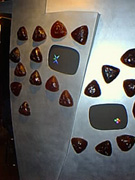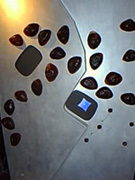| Meteor Music | Meteorite Museum |
Composition, Sound Design and Interaction for Meteorite
 |
 |
 |
Two deep interests of mine - a lifelong fascination with architecture and its relationship to music, and a desire to develop technology that invites and stimulates active music-making for everyone - have made it a special pleasure to work with Andre Heller on music and sound for "Meteorite". I have conceived the overall sonic landscape for the museum, composed music for each individual experience (except for several video installations which have their own soundtracks), and worked with my team at the MIT Media Lab to create the TransFlow Room, where music and images can be shaped and transformed by the public.
For the overall sound design of Meteorite, I have composed "Meteor Drone", a four part composition which is heard throughout the large, open museum space, starting and ending with the bridge that connects the "meteor" with the entrance lobby. The Meteor Drone is like a surrounding atmosphere: barely noticeable, but adding direction and continuity to the museum visit. Different aspects of the music are revealed as one wanders through the space, on connecting ramps, from room-to-room. At first, a low, pulsating tone is heard, gently but firmly announcing the entrance into a new world; gradually harmonics and overtones appear which take on more and more independence; these harmonics transform again into rapidly shimmering harmonies; these eventually stabilize into a soaring cello melody (featuring the hauntingly eloquent playing of cellist Matt Haimovitz) heard upon exiting the museum. The whole progression from simplicity to delicate detail to memorable song is an enhancement and metaphor for the visitor's process of exploration, reflection and astonishment at Meteorite.
Each experience also has its own "theme music." On the first ramp is a "Whisper Collage" of welcoming voices recorded both in Essen and Boston. The "VideoDom Music" extends these whispers - the world brought in from outside - into a quicker-cut collage of children's chattering, an ethereal choir, multifarious musical fragments, and a Bach-like organ fantasia trying to be heard; the whole is like a hidden message from a far-away galaxy, felt deeply if not completely understood. Ethereal in another way is the "Red Meditation" music (composed for what I call the "red egg"); here a long, evolving melody (sung in hyper-Gregorian style by soprano Noel Bisson) builds upon itself, drawing the listener in ever closer, envelopping, calming and healing. My music for "LightShade" is coordinated with bright light flashes, providing shocking and humorous sounds to dramatize visitors' shadows being fixed on the room's walls.
In the final chamber, the interactive "TransFlow Room," the music and images swirl circularly and become transformed as special wall-mounted sensors are touched and explored by the public. An extension of concepts developed for my recent "Brain Opera" project, the TransFlow Room functions as a single instrument, in which people join together to create the evolving sound and images. Here Meteorite "voyagers" awaken from their passive, dreamlike journey and become active participants, shaping the music and light to create a surprising, mysterious and stimulating new artistic force. Everything moves rapidly, constantly, but always delicately. Moving clockwise around the room, one discovers ways to make more and more intricate effects, finally resynchronizing and calming everything at the final "interactive panels" before exiting. TransFlow is an experience in artistic expression and participation, but also in communication - people learn to play this instrument together, sending sounds and images back and forth, listening to each other, and eventually coordinating to create a beautiful ensemble performance.
TransFlow was designed entirely by my team and I at the MIT Media Lab, with Chris Dodge in charge of visual design and technology, and Ray Kinoshita responsible for the set and interfaces. In fact, the TransFlow Room is the first permanent installation anywhere in the world designed by the Media Lab.
The 45-minute, eight-movement "Meteor Music" unfolds, movement by movement, as visitors journey through each part of Meteorite at their own pace, exploring and creating in this unprecedented environment.